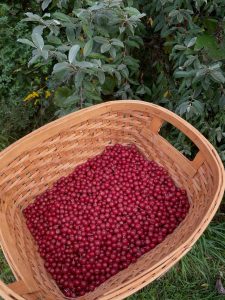Page Created by Connecticut Foraging Club
Upcoming Events | Meet the Instructors | Plant Archive | Mushroom Archive
----------------
Upcoming Events | Meet the Instructors | Plant Archive | Mushroom Archive
----------------
The Bulbous Honey Mushroom (Armillaria gallica) is a parasitic and saprobic mushroom that can be found July-November.

Honey mushrooms will always be growing on wood, although sometimes the wood is buried. The mushrooms grow in clusters. Cap color varies from yellow to brown. Armillaria gallica tends to have more of a brown cap color, while Armillaria mellea has a honey yellow cap color. The cap will have small black hairs that are more concentrated in the center of the cap. Gills are creamy white and usually run slightly down the stem. Spore print is creamy white.

Armillaria gallica has a veil that covers the gills when the mushroom is young. Young caps are convex. When the mushroom is older, caps flatten out and the remaining veil can be seen as a ring on the stem.

Honey mushrooms are best harvested young, when the veil is covering the gills. Older mushrooms are more likely to cause gastrointestinal upset. The stem should cut clean with no big damage.
Caps must be cooked for at least 15 minutes. Stems are fibrous so are best discarded.
Honey mushrooms have a rich flavor with a slightly sweet finish and a slimy texture. They are best in soups and sauces. Honey mushrooms also dry well. Some people get stomach upset from consuming honey mushrooms, so it is best to start with a small amount the first time consuming them.

Honey mushrooms have potential medicinal benefits that range from protecting brain health, treating diabetes, decreasing depression symptoms, and regulating cholesterol.
--
Written by Amy Demers, founder of the Connecticut Foraging Club. To learn more about foraging in Connecticut, check out our upcoming classes.






